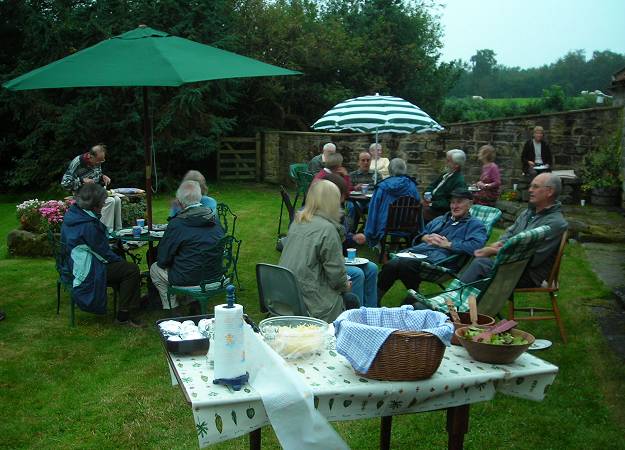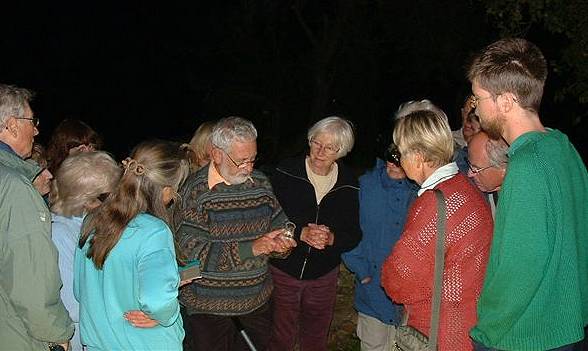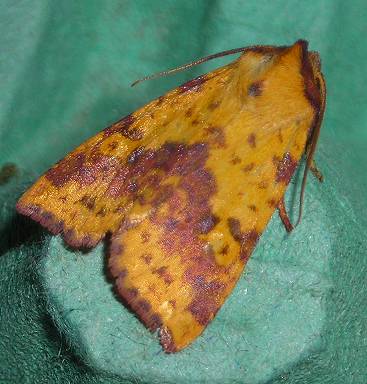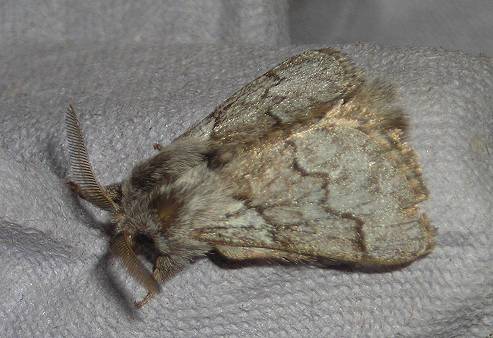
Back to the Ryenats home pages
This was something of an experiment: to have an August meeting, and also to hold a barbecue as part of the “trip”. I think we can say it was a resounding success – more than 25 members and guests attended, a considerable improvement on our normal turnout, particularly given the rather uninspiring weather which was cloudy and humid though thankfully dry. Tom and Janet Denney had put on a wonderful barbecue in their garden, and organised everything beautifully, including a parking field complete with signs.

Once we were all gathered and had moved on from the sausages and burgers to the excellent cake and flapjack (thanks, Janet and Marion) Tom introduced Terry Crawford. Terry is an expert on moths from York, and he had brought his trap and set it up in the garden. He gave us a brief and very informative introduction on how it worked and on moths themselves, as well as some ideas on the species we might find. I was very pleased to discover that the trap did not harm the insects. It consists essentially of a very bright light set above a funnel leading into what looked like a giant salad spinner, with pieces of egg-trays in the bottom for the moths to rest on or hide under. What happens is that the moths are attracted to the light, land on it and then either fall or jump off (probably because the light is hot) and fall into the chamber below, which is a couple of feet in diameter. Terry runs the trap every night in his garden, and frequently gets more than 300 insects – he counts them at tea-time the following day as apparently they are too lively in the mornings and tend to fly out before he can identify and count them.
Terry then handed over to Michael Thompson who had brought his bat-box along. He gave us some information about the local bats, and how they interacted with moths (bats eat a lot of moths, in particular yellow underwings) – and Janet showed us a mummified brown long-eared bat she had found in the loft. We were all amazed at just how tiny, light and delicate it was – and of course the extraordinary ears which are longer than the whole of the rest of its head. There were a few bats flying over the garden, but they did not fall within the range of the bat-box (which probably means they were the long-eared bats). Although the echo-location frequency is way above human hearing, young people can hear the vocalisation squeaks. I was distressed to find I no longer could even though Richard picked them up clearly.

Terry showing us a “potted” moth
Once it got dark we gathered round the trap (at this point it became clear why we’d been advised to bring our sunglasses as the mercury lamp was very bright) and watched as various moths approached the light and either fell in or landed on or around the chamber where they could be picked up (gently!) or put in small plastic pots. Terry then identified them and handed the pots around for us all to see the moths close up. In the light of a torch they were very beautiful (the bluish light of the main bulb doesn’t show the colours to the best advantage). Soon moths were arriving thick and fast, landing on our clothing or blundering into us in the case of the large yellow underwing – one could see why they are the favoured prey of the bats, having a large, meaty body! There were also numerous other insects, notably caddis-flies, craneflies, a few lacewings and rather too many midges. Some of these also ended up in the trap.
 |

|
| Pink-barred Sallow | Pale Eggar |
After an hour or so we took the trap to the summerhouse, where Terry opened it and carefully removed the pieces of egg-box one by one, showing us the moths that were there. Several large yellow underwings flew out and then flapped about the light but most of the species were better behaved. I think the most beautiful we saw was the pink-barred sallow with its autumnal tints, but the markings on the pale eggar were also very attractive. We also saw two different colourways of the marbled carpet (very confusing, as to a novice they appear to be two entirely different species).
Tom proposed a vote of thanks to Terry for showing us some of the moths of Ryedale, and we all thanked Tom and Janet for hosting such a successful evening. And it didn’t rain once.
Below is a list of the species of macromoths seen on the evening of 30th August when the Ryedale Natural History Society met at Sykes House, Rudland.
| Lasiocampidae | |
| 16321 | Pale Eggar2 |
Geometridae | |
| 1728 | Garden Carpet3,4 |
| 1755 | Chevron2 |
| 1764 | Common Marbled Carpet3,4 |
Notodontidae | |
| 2000 | Iron Prominent2,4 |
Noctuidae | |
| 2107 | Large Yellow Underwing3,5 |
| 2109 | Lesser Yellow Underwing3 |
| 2134 | Square-spot Rustic3 |
| 2273 | Pink-barred Sallow |
| 2439 | Gold Spot4 |
| 2441 | Silver Y3,6 |
| 2474 | Straw Dot4,7 |
Notes
NB By convention, with over-night trapping, dates refer to the evening, not the morning.
1 In the British List of butterflies and moths, each species is assigned a number called its Bradley & Fletcher number. Broadly speaking, these reflect the order of listing in modern books and websites, although there are some breaks in sequence arising from subsequent systematic rearrangements.
2 These species are characteristic of the local habitats, i.e. heather moorland, birch.
3 These are “weed species” that you can expect to find in a wide range of habitats.
4 Bivoltine; likely to be second-generation adults.
5 Certainly the most common species on the night, and this is generally true from July to September for many habitats. The resident population is reinforced by immigrants. My largest catch of this species was on 13/08/2001 when I took 687 out of a total of 988 moths.
6 This is an immigrant, mainly from southern Europe and northern Africa, in abundant numbers in some years, and can be a crop-pest. It can produce two to three generations over our summer and into the autumn (6–7 weeks from egg to adult), but mostly fails to survive our winters. My maximum catch was on 18/08/1996 (a very good year for migrants) when I took 269 Silver Y out of 790 moths. The good condition of the Silver Y that we saw suggests that they were locally bred.
7 This little moth has shown a spectacular increase in recent years throughout Yorkshire, and a check using Google shows this to be true for many other areas of England. My figures are: none (before 2004), 8 (2004), 31 (2005), 144 (2006), 316 (2007), and 1613 up to 1 September in this year; maximum count was 391 on 29/08/2008. Many Yorkshire “moth-ers”, like me, initially thought that they might have been dismissing it in previous years as a “micro” – not so!
2008, so far, is not a good year for Lepidoptera. In 19 years at my current house, it is the 2nd worst year for number of species (183) to 1st September; last year was worst with 171; the median number to this date is 202 species. By contrast, it is only the 11th worst year for the number of moths (11728) to 1st September, near the median of 11091. This discrepancy arises mainly from the currently high numbers of Large Yellow Underwing, Straw Dot and Setaceous Hebrew Character (B&F 2126) which mask crashes of many other species last year and this year to the extent that many are not being caught at all. I think that some interesting analyses lie ahead, especially if they can involve similar data from several sites. You were certainly lucky with the weather on your night. Many moth-ers have commented on the good catches in the last week of August, and allowing for the cooler evening at 200 metres, we still had sufficient activity for you to see a trap in action and a reasonable diversity of species. But the right sort of night in late July is a totally different experience, not least for the swarms of biting midges that are also attracted. My best night ever was 21/07/1996 when I took 1328 moths of 56 species, and also several inches of Diptera at the bottom of the trap; there were large thunder storms floating around which, together with warmth and humidity, seemed to stimulate the insects into flight.
Currently, the two most popular books for identification of “macros” are:
Waring, P., Townsend, M. and Lewington, R. 2003. Field Guide to the Moths of Great Britain and Ireland. British Wildlife Publishing.
A more concise version designed for use in the field is:
Townsend, M., Waring, P. and Lewington, R. 2007. Concise Guide to the Moths of Great Britain and Ireland. British Wildlife Publishing.
I believe that another book is due for publication this autumn and that it will include good coverage of the more common “micros”.
The best website for identification is: http://ukmoths.org.uk/
Much useful information can be found at: http://www.butterfly-conservation.org/ and at the websites of local branches of Butterfly Conservation, e.g. Yorkshire: http://www.yorkshirebutterflies.org.uk/
Butterfly Conservation (moths and butterflies) is an excellent charity that gives extremely good value for the annual membership. You get a really good national magazine, membership of a local branch with further documentation (the 2007 Yorkshire Lepidoptera Report, published jointly with the YNU, runs to 96 pages), and very many free events across the country, including opportunities to visit special sites for rare species. Also, everybody is very friendly and welcoming.
In Yorkshire we have the “Yorkshiremoths” website (http://www.yorkshiremoths.pwp.blueyonder.co.uk/) and you can read the e-mail postings without joining the group.
The YNU Lepidoptera Group (i.e. moths and butterflies) meets annually in early March at Bramham Village Hall. In a very informal way we have forged an extremely productive and successful co-operation between the YNU and Butterfly Conservation. Anyone is welcome to attend, and you don’t have to be a member of either parent organisation (although all of you are affiliated to the YNU via the Ryedale Natural History Society, as it happens). Please e-mail me if you would be interested in receiving a copy of the draft minutes of the meeting held last March (I chair the Group).
With best wishes to you all.
Terry.
Text © Gill Smith and Terry Crawford August 2008. Pictures © Gill Smith & Tom Denney 2008
Back to the Top and Ryenats home pages